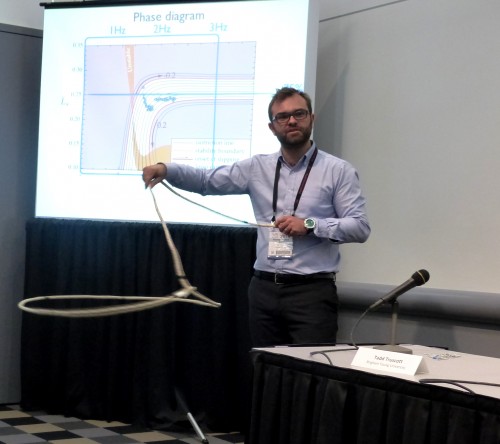
Pierre-Thomas Brun shows off his lassoing skills.
By Tushna Commissariat at the APS March Meeting in Denver
It has been another exceedingly busy day the APS March Meeting – there were sessions on the SQUID’s many applications, robotic clams, global health physics and the spread of epidemics, and even some toys based on physics principles. Here’s another quick round-up of the fascinating talks.
On SQUID row
It’s the 50th birthday of the superconducting quantum interference device or SQUID – a very sensitive magnetometer that accurately measures extremely subtle magnetic fields – this year, and there were sessions this morning to discuss its impact to date as well as possible future applications. Kent Irwin from Stanford University discussed how superconducting photon detectors that are used in a host of astronomical and cosmological observations are being amplified using SQUIDs. Such SQUID-boosted sensors are being used to make more accurate measurements of the cosmic microwave background (CMB) – to look at its power as well as certain polarizations modes it exhibits. As certain experiments look for signs of gravitational waves in in the CMB polarization, this could be particularly helpful.
Next, Catherine Foley from CSIRO spoke about the how the field of geological exploration and observations could benefit from the SQUID. She talked about how it was the discovery of high-temperature superconductors that endeared the SQUID to the mining industry and how it was then adapted to meet mineral-exploration needs. The method that uses “transient electromagnetics” along with SQUIDS was ultimately successful in making mineral discoveries and proved financially fruitful. Foley also touched on the challenges involved, including convincing the industry that using a SQUID was better than the more commonly used magnetic coil.
Clammy robots
Kerstin Nordstrom from the University of Maryland is fascinated by the Atlantic razor clam, thanks to how quickly and efficiently it can burrow into silty underwater soil. Nordstrom explained that as the bivalve contracts and expands while it burrows, it excites the soil particles around it, making the earth act almost like a fluid that the clam can easily dig through. Her team has built a robotic version of the mollusc, in an attempt to see if it could work as a novel, lightweight anchor for small boats. The anchor could tunnel into the underwater soil while the boat is moored and then just as easily dig its way back out when the time came to weigh anchor and head home.
Playful physics
Ending the day on a lighter note was a talk by two researchers who look to physics for inspiration when making toys. Tadd Truscott from Brigham Young University spent a lot of time skipping stones with his son. When he came across the Waboba ball that easily skips on water, the physicist in him was intrigued. He and colleagues looked into the elasticity and fluid dynamics involved with the Waboba ball and found that elasticity was key. As the Waboba ball hits water, it deforms into a pancake-like shape, increasing the amount of its surface area in contact with the water, inducing a hydrodynamic lift that skips it forward.
Pierre-Thomas Brun from the Ecole Polytechnique Fédérale de Lausanne in Switzerland is more of a cowboy at heart. His work looks at the art of lasso throwing and he has modelled one of the simplest tricks, known as “flat loop”, that professional trick ropers perform. He also compared his simulations with high-speed videos of a professional doing the same trick, as well as a mechanical “robo-cowboy” hand and wrist. His results offer a guide on how to spin a lasso like a real live cowboy. The work may also have applications in understanding how ropes, which are ubiquitous in nature – from DNA chains to yarn to hair to transatlantic oceanic cables – can be studied. Brun’s tips for someone starting out with their first lasso: buy a flexible rope and begin with a large loop.
Guidelines
Show/hide formatting guidelines
this text was deletedwhere people live in harmony with nature and animals</q>
Some text